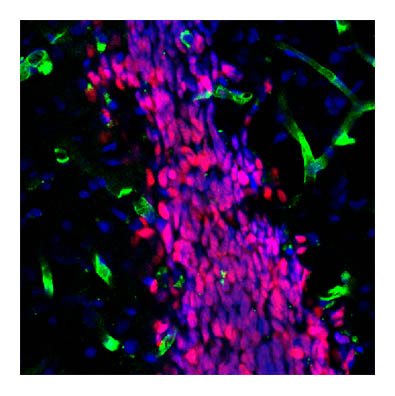
Stereo Investigator Assists Stanford Stroke Center Scientists in Stem Cell Research
A stroke can leave its victim mentally and physically devastated. Recovery is demanding, and takes drive and determination. If the patient doesn’t receive medical attention within the small, critical window of time after the stroke occurs, chances of a quick recovery are slim. Developments in stem cell research find doctors optimistic about new possibilities for stroke rehabilitation.
Scientists at the Stanford Stroke Center, one of the leading centers for stroke research in the world, are working on figuring out how transplanted stem cells affect the host brain. They’re specifically working toward determining which trophic factors—substances secreted by cells—are necessary for stem cell transplantation to be effective. One recent study focused on vascular endothelial growth factor (VEGF), a factor associated with neurological recovery in stroke patients.
As described in their paper “Transplanted Stem Cell-secreted VEGF Effects Post-stroke Recovery, Inflammation, and Vascular Repair,” Drs. Nobutaka Horie, Gary Steinberg, and their team of researchers found VEGF to be essential for hCNS-SCns-induced recovery. The research team studied the brains of rats, which had undergone stroke surgery and were injected with human central nervous system stem cells (hCNS-SCns). After thorough analysis of various parameters, including stereological quantification of the brain inflammatory response and stem cell survival using Stereo Investigator, the Stanford team determined the stem cells helped suppress inflammation, helped form new blood vessels, and improved blood-brain barrier integrity.”
“Subacute cell transplantation therapy offers a multimodal strategy for brain repair that could significantly expand the therapeutic window for stroke,” say the authors in “Transplanted Stem Cell-secreted VEGF Effects Post-stroke Recovery, Inflammation, and Vascular Repair.”
Access the free abstract or download the full article at Stem Cells.
Horie, N., Pereira, M. P., Niizuma, K., Sun, G., Keren-Gill, H., Encarnacion, A., Shamloo, M., Hamilton, S. A., Jiang, K., Huhn, S., Palmer, T. D., Bliss, T. M. and Steinberg, G. K. (2011), Transplanted Stem Cell-Secreted Vascular Endothelial Growth Factor Effects Poststroke Recovery, Inflammation, and Vascular Repair. STEM CELLS, 29: 274–285. doi: 10.1002/stem.584
{Image of transplanted stem cells (pink) and blood vessels (green) courtesy of Stanford University}



